by W.S. Cranshaw* (7/14)
Quick Facts…
- The ‘miller moth,’ common in Colorado and adjacent states, is the adult stage of the army cutworm.
- The caterpillar stage of the army cutworm feeds on crops and garden plants in winter and early spring.
- The adult form of the army cutworm feeds on nectar in late spring through early fall. It does not lay eggs during this time.
- During warm months the ‘miller moths’ migrate to higher elevations as they seek flowering plants. Areas close to the mountains
receive moths that may have migrated well over a hundred miles en route to summer feeding sites.
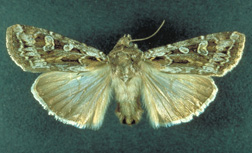
Figure 1: Army cutworm moth. (Photo courtesy of J. Capinera.) |
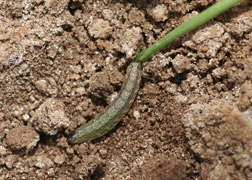
Figure 2. Army cutworm with damaged seedling. |
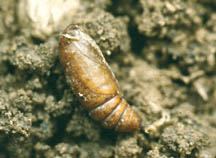
Figure 3. Army cutworm pupa. (Photo by W. Cranshaw.) |
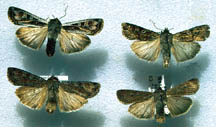
Figure 4. Army cutworm moths showing variable patterning.
|
‘Miller moth’ is the term given to any type of moth that is abundant in and around homes. In Colorado and much of the Rocky Mountain west, the common ‘miller’ is the adult stage of the army cutworm, Euxoa auxiliaris. In some years it becomes a serious nuisance pest, particularly during its annual migration from the plains to the mountains in late spring.
Army cutworm moths have a wing span of 1.5 to 2 inches. It is generally gray or light brown with wavy dark and light markings on the wings. The wing patterns of the moths are variable in color and markings, but all have a distinctive kidney-shaped marking on the forewing.
Severe nuisance problems with “millers” seem to be limited to eastern Colorado. However, army cutworms also occur in western Colorado and may be an important crop pests in late winter and spring. Adults similarly migrate to the mountains to spend the summer but less frequently occur as serious nuisance pests along the West Slope.
Life History and Habits
The army cutworm has an unusual life history. Eggs are laid by the moths in late summer and early fall. Most eggs are laid in weedy areas of wheat fields, alfalfa fields, or other areas where vegetation is thick—including turfgrass. Eggs hatch within a few weeks and the young caterpillars begin to feed. Army cutworm has a wide range of plants on which it feeds. It prefers broadleaf plants but will also feed on grasses.
Army cutworms spend the winter as a partially grown caterpillar, feeding as temperatures allow. In early spring the cutworms may damage crops, particularly alfalfa and winter wheat. They may also damage garden plants and are common in lawns. When high populations occur that consume all plants they may take on the “armyworm” habit of banding together crawling across fields or highways. Army cutworms become full grown by mid-spring, burrow into the soil, and pupate. Pupation can occur as early as March or may extend into early May, depending on temperatures.
Between three to six weeks later, the adult “miller” stage of the insect emerges. Next, they migrate and ultimately settle at higher elevations where they spend a few months, feeding on nectar and resting in sheltered areas. During this time they are in reproductive diapause, a physiological state during which they do not produce nor lay eggs. In early fall or late summer, they return to lower elevations, come out of diapause, and begin to lay eggs, repeating the annual, single generation life cycle.
Miller Moth Migrations
Miller moths are the migrating adult stage of the army cutworm. In eastern Colorado, spring flights move westward, originating from moths that developed across eastern Colorado and border areas of Wyoming, Nebraska, Kansas, and Oklahoma where army cutworm also occurs.
A likely explanation for the migration is that it allows the moths a reliable source of summer flowers. Flowers provide nectar which the moths use for food. In addition, the cooler temperatures of the higher elevations may be less stressful to the moths, allowing them to conserve energy and live longer.
During outbreak years, miller moth flights typically last five to six weeks, generally starting between mid-May and early June. However, they tend to cause most nuisance problems for only two to three weeks.
Exactly when the flights occur and for how long varies. During the 1991 outbreak high populations were present from early May through mid-June. However, in 1990, a year that also was above average for miller flights, heavy flights were not noted until early June and lasted about a month. In the warm, dry 2002 season, nuisance numbers of miller moths along the Front Range occurred over a very extended period—from late April through early July—and were concentrated around irrigated areas due to the drought.
Miller moths avoid daylight and seek shelter before day break. Ideally, a daytime shelter is dark and tight. Small cracks in the doorways of homes, garages, and cars make perfect hiding spots. Often moths may be found clustered together in particularly favorable sites. Since cracks often continue into the living space of a home (or a garage, car, etc.) a ‘wrong’ turn may lead them indoors. At night, the moths emerge from the daytime shelters to resume their migratory flights and feed.
The return flights (mountains to the plains) in early fall usually span a shorter period of time, typically beginning in the latter half of September. However, since the majority of moths die during the summer the return flight is less obvious.
The number of miller moths in late spring is primarily related to the number of army cutworm caterpillars which occurred earlier in the season. Outbreaks of the army cutworm are usually followed by large flights of miller moths.
Many things influence cutworm outbreaks. Wet weather and extremely cold winter conditions may kill many of the caterpillars. The effectiveness of natural enemies, such as ground beetles and parasitic wasps, help regulate cutworm populations. Plowing fields where cutworms develop kills many, as does tilling gardens.
Miller moths may concentrate around buildings more intensively during some years. The presence of flowering plants and local humidity conditions are suspected as being important in concentrations of miller moths. This effect is seen particularly during drought years when there are few natural sources of flowering plants at lower elevations. The presence of certain highly favored flowering plants, notably Russian olive, is frequently associated with localized nuisance problems.
Damage by Miller Moths
The caterpillar stage of the army cutworm is sometimes an important crop pest in the spring. For example, during outbreak years thousands of acres of alfalfa, winter wheat, and other crops are treated with insecticides for army cutworm control (See fact sheets 5.577, Caterpillars in Small Grains and 5.565, Caterpillars in Field Crops: III.). Army cutworms are also common early season pests of gardens and feed on lawn grasses along with sod webworms and other cutworms.
However, the adult miller stage is primarily a nuisance—albeit a considerable nuisance at times. Moths in the home do not feed or lay eggs. During the migratory flights, the moths do not produce nor lay eggs. Furthermore, they do not feed on any household furnishings or food. Moths in the home will eventually find a way outdoors or die without reproducing.
When large numbers die in a home there may be a small odor problem (due to the fat in their bodies turning rancid). Also, unless they are cleaned out, old moths may serve as food for carpet beetles (See fact sheet 5.549, Carpet Beetles.) and other household scavengers. These secondary insects may become problems in subsequent years.
Miller moths also may spot drapes or other surfaces, such as unfinished wood because they excrete fluid for most of their adult life. This product is slightly acidic and is sprayed by the moth. Presumably the purpose of this is defensive, although it is not particularly irritating.
Probably the greatest damage created by millers is the lost sleep resulting from their flying about the room and the needless worry that they may reproduce in the home and cause harm to household furnishings.
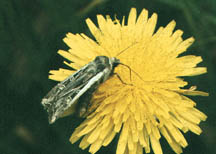
Figure 5. Miller moth feeding at a flower. (Photo by W. Cranshaw.) |
Natural Enemies of Miller Moths
The caterpillar stage of the army cutworm has many natural enemies. Predatory ground beetles, and many birds eat cutworms. Adult millers may be eaten by bats or birds.
One commonly observed phenomenon involving birds is swallows concentrating at intersections where they feed on miller moths. (House sparrows and other birds also are found at these sites, feeding on wounded moths.) This likely occurs because many miller moths seek shelter in automobiles and emerge while the cars are idling at stop lights. Furthermore, many moths are released as drivers open vehicle windows at intersections to let the moths escape.
Other wildlife feed on miller moths as well. For example, they can be an important part of the grizzly bear’s diet in the Yellowstone National Park area. Grizzly’s feed on the fat-rich moths that rest under loose rocks.
However, factors that determine the abundance of miller moths from season to season are largely unknown. Undoubtably certain weather patterns have a great effect.
Miller Moth Control Around Homes
Before miller moth migrations, seal any obvious openings, particularly around windows and doors. Also reduce lighting at night in and around the home during flights. This includes turning off all unnecessary lights or substituting non-attractive yellow lights.
Landscaping may affect the number of millers you’ll see because it may provide food (nectar) and/or shelter. Some of the flowering plants most readily visited by miller moths along the Front Range include lilac, cherries, spirea, cotoneaster, horsechestnut, raspberry, and Russian olive. Dark, dense plants such as cotoneaster shrubs, spruce, and pines will be used most often as shelter by miller moths. Landscaping considerations can be important in the tendency of miller moths to linger around a home.
Once in the home, the best way to remove the moths is to swat or vacuum them, or attract them to traps. An easy trap to make is to suspend a light bulb over a bucket partially filled with soapy water. Moths attracted to the light often will fall into the water and be killed. (If this is attempted some wetting agent, such as soap or detergent, must be added or many moths will escape. Also, there are obvious dangers when bringing water and electrical equipment in close proximity and great care should be given to the situation. This includes use of a GFI receptacle for safety.)
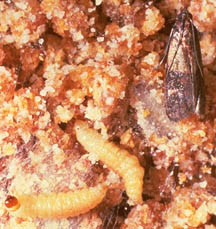
Figure 6: Indian meal moths cause problems on dried food products in the home. Adult and larvae shown. |
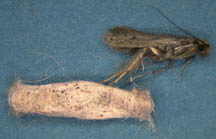
Figure 7: Casemaking clothes moths: adult and webbing. |
Army cutworm moths are very sensitive to certain noises, making erratic flying movements in response. Among the sounds which elicit greatest response are jingling keys, dog tags, rattling coins, and crumpled pop cans. The likely reason for this is that certain sound frequencies are produced to which the moths are sensitive. Many cutworm moths make evasive movements in response to frequencies used by bats during echolocation of prey. Since bats are an important predator of night flying moths, rapid evasive movements are a means of protection. Regardless, jingling keys or making similar noises can disturb many of the moths in the home causing them to seek shelter and can sometimes dramatically speed the capture rate when using the soapy water trap.
Insecticides have little or no place in controlling millers. The moths are not very susceptible to insecticides. Furthermore, any moths killed will be rapidly replaced by new moths migrating into the area nightly.
Other Moths Common in Homes
The most common moth found in Colorado homes is the Indian meal moth. Adults are much smaller than the miller moth, about 1/2 inch, is yellow brown with a dark tip on the wing. The caterpillars of the Indian meal moth develop in various cereal products, nuts, dried flowers, and other stored foods. Information on the Indian meal moth can be found in fact sheet 5.598, Indian Meal Moth.
Clothes moths are very rare in Colorado, but can occur when infested woolen items are introduced into a home. It is a very pale colored moth even smaller than the Indian meal moth. They are rarely observed flying and do so only when dark.
*Colorado State University Extension entomologist and professor, bioagricultural sciences and pest management. 5/03. Revised 7/14.
Colorado State University, U.S. Department of Agriculture, and Colorado counties cooperating. Extension programs are available to all without discrimination. No endorsement of products mentioned is intended nor is criticism implied of products not mentioned.
Go to top of this page.





